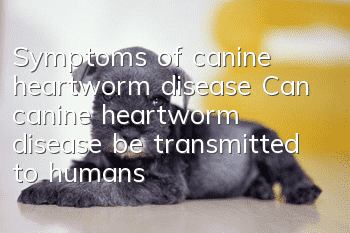What do you know about common causes of dog illness?

Symptoms of dog illness: runny nose
Healthy dogs almost never have runny noses. When dogs have a cold or have respiratory inflammation, they will have runny noses. If the dog has purulent inflammation, the clear nasal discharge may evolve into purulent nasal discharge. Therefore, when the dog starts sneezing and has a runny nose, the owner should pay attention to whether the dog has a cold.Symptoms of dog illness: fever
Many dog diseases are accompanied by high fever. Generally, the normal body temperature of adult dogs is 37.5℃-38.7℃, and the normal body temperature of puppies is between 37.5℃ and 38.7℃. 38.5℃-39.2℃. The temperature difference between day and night generally does not exceed 1 degree. If it is different from the normal body temperature, it means that the dog’s body temperature is abnormal. When a dog has symptoms such as sneezing, runny nose or other abnormal symptoms, it is best to use a thermometer to measure the dog's temperature to see if there are any symptoms of fever.Symptoms of dog illness: shivering for no reason
Sometimes dogs’ limbs are weak and trembling, which may be a sign of calcium deficiency. At this time, we should supplement the dog with calcium. But when your dog starts shaking for no reason, don’t think it’s playing. It could be a neurological problem, possibly caused by encephalitis or canine distemper. Therefore, owners who discover this situation must take their dogs to the hospital immediately.Symptoms of dog illness: loss of appetite
A dog who usually looks forward to eating every day suddenly loses food. Is he planning to lose weight? In fact, owners should be alert at this time. Many diseases can cause dogs to lose their appetite, such as gastrointestinal diseases and other systemic acute infectious diseases. However, sometimes taking medicine can cause a dog to lose its appetite. Pay attention to whether there are any other symptoms besides loss of appetite.Symptoms of dog illness: difficulty breathing, coughing
Healthy dog breathing is usually an accurate and rhythmic alternating movement. If the respiratory rate is significantly accelerated and the breathing is increased, The depth indicates that the dog may be suffering from respiratory disease and should not be taken lightly.If the dog opens its mouth, straightens its head and neck, moves its ribs upward and expands its elbows outward when breathing, it is dyspnea caused by airway obstruction. When a dog's breathing is shallow and rapid, it indicates that the lungs cannot fully expand, which is common in tracheitis, bronchitis, rib fractures, pneumonia, pneumothorax, or pleurisy.
If you find that your dog has symptoms of coughing, you should take medication as soon as possible. If the dog is still not relieved after taking the medication, you should go to the hospital for a respiratory examination.
Random articles
- How to get rid of fleas on dogs How to get rid of fleas on dogs
- Five things dogs shouldn’t eat. Not all dog foods can be eaten by dogs.
- Which plants are harmful to dogs? If you have plants at home, you must pay attention
- What are the advantages of Labradors? Here are the six advantages of Labradors that you may not know about.
- Domestic Dog Food Ranking Dog Food Ranking Which brand do you choose for your dog?
- How to choose a golden retriever puppy? What aspects should you pay attention to?
- Can dogs be dewormed during menstruation? What owners must know during dog menstruation!
- What to do when dogs fight? Owners can try these two methods
- There is a reason why dogs don’t wear shoes. For the sake of dogs, it is better to distinguish the situation and wear shoes.
- Causes of constipation in dogs. What are the factors that affect constipation in dogs? What should owners know?



